
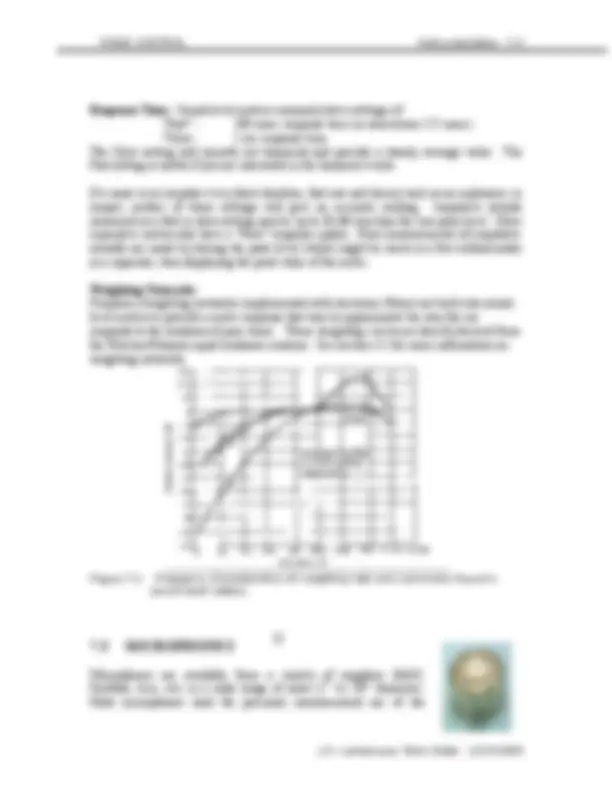
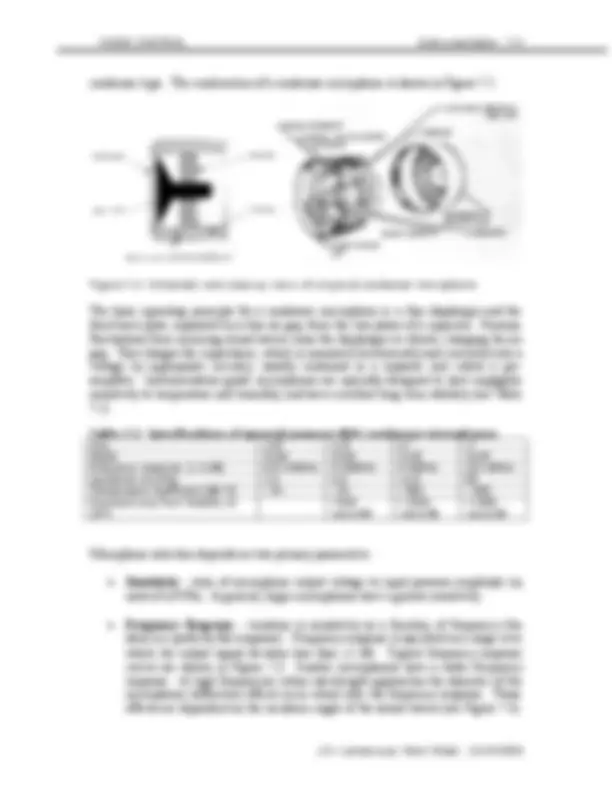
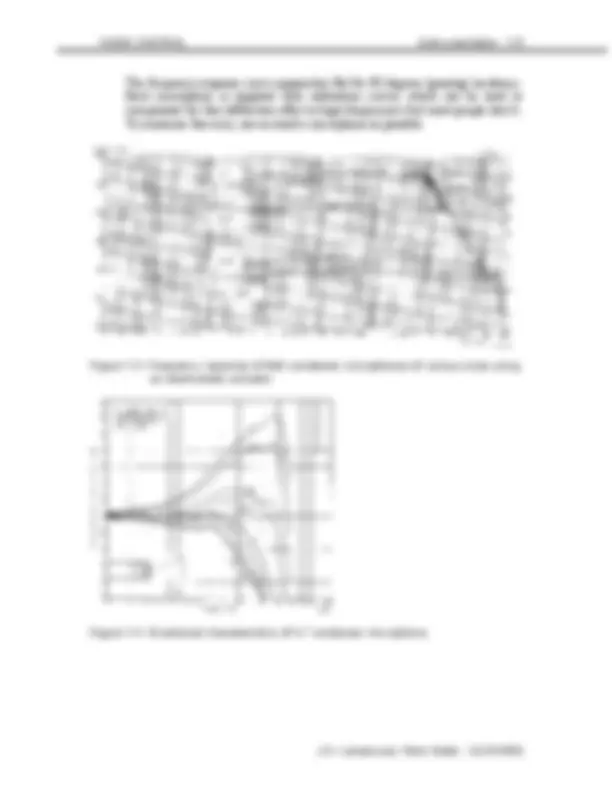
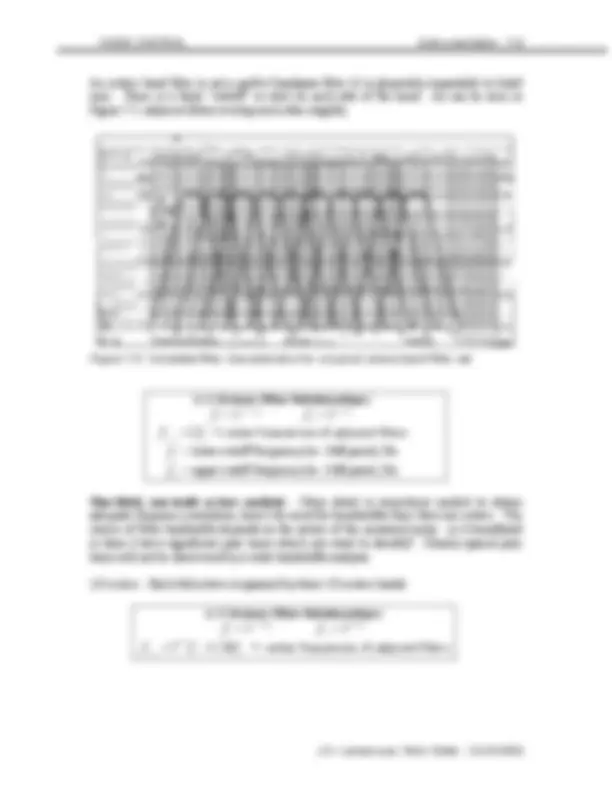
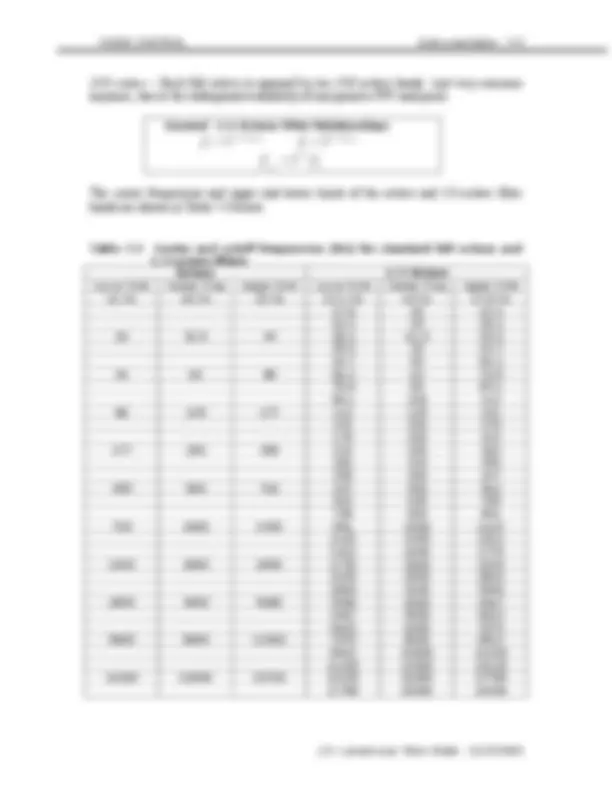
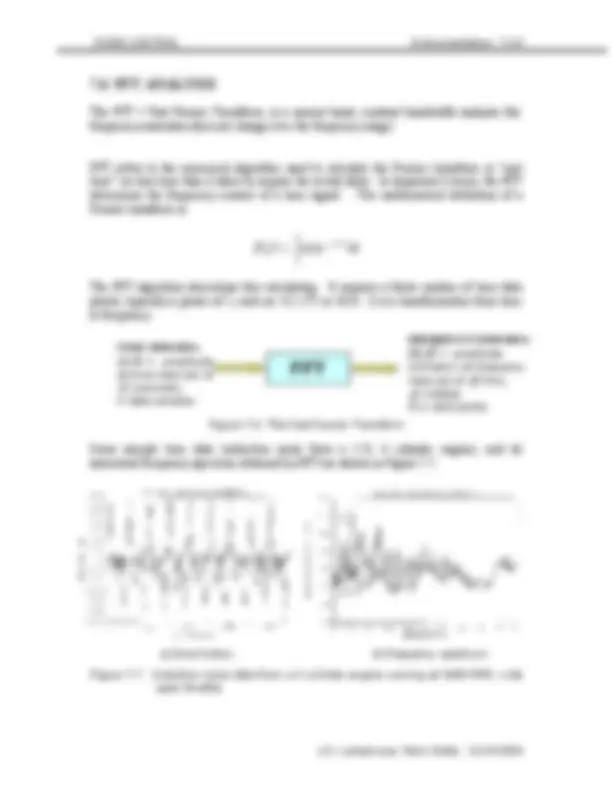
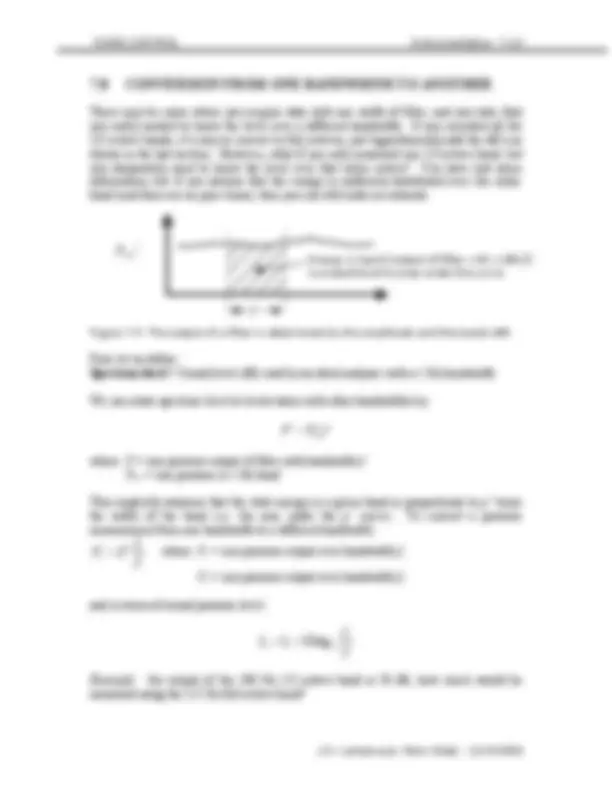
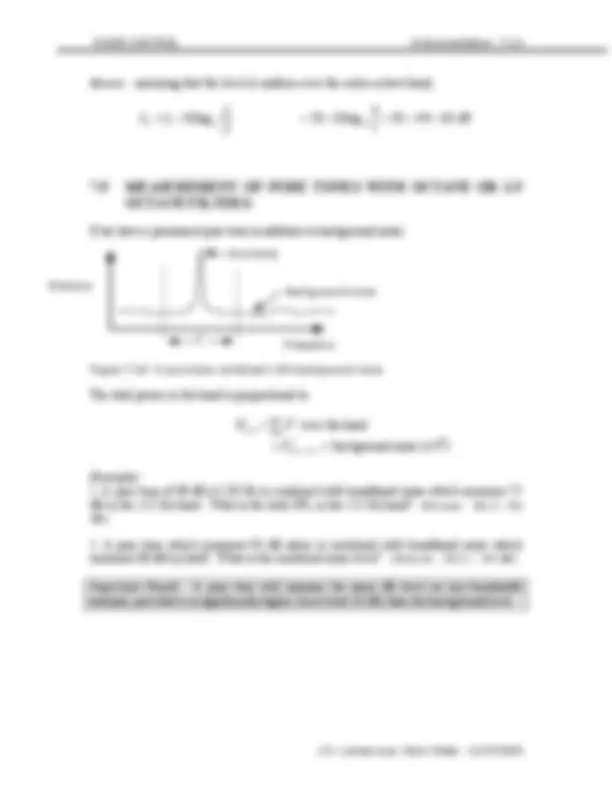
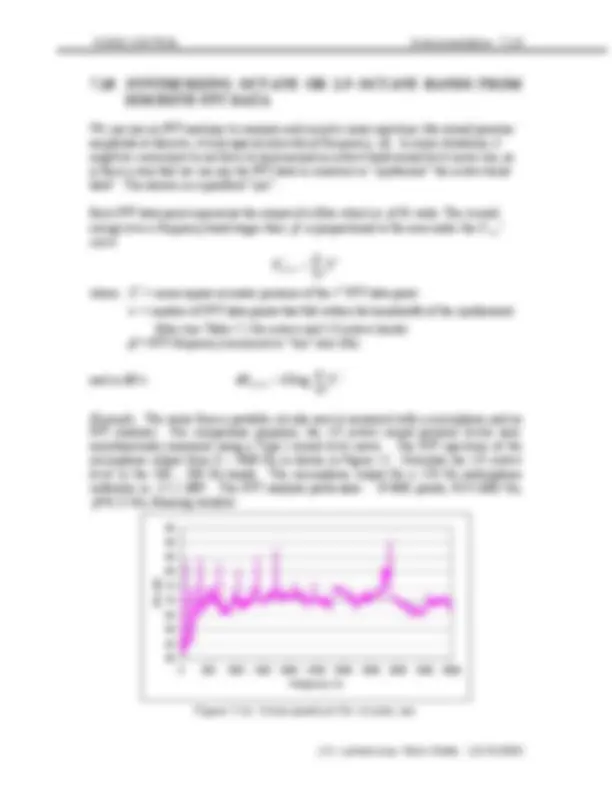
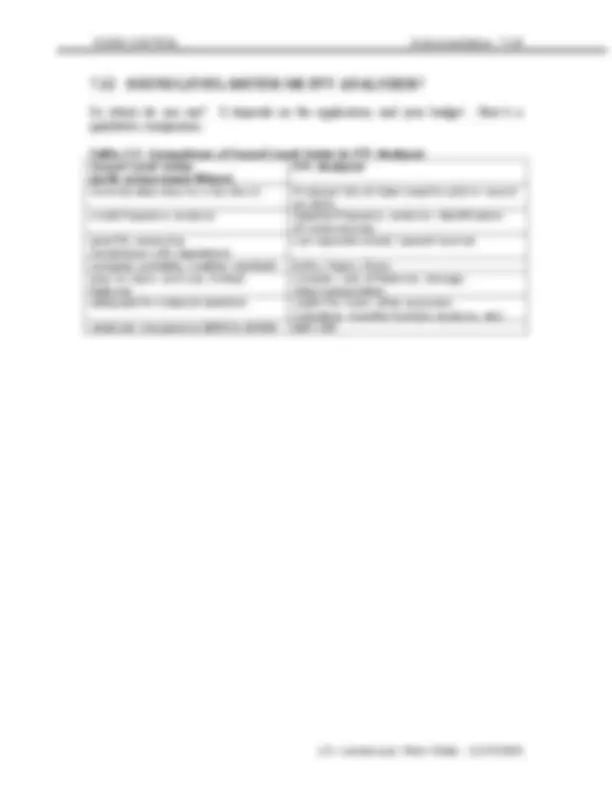


Study with the several resources on Docsity

Earn points by helping other students or get them with a premium plan


Prepare for your exams
Study with the several resources on Docsity

Earn points to download
Earn points by helping other students or get them with a premium plan
Community
Ask the community for help and clear up your study doubts
Discover the best universities in your country according to Docsity users
Free resources
Download our free guides on studying techniques, anxiety management strategies, and thesis advice from Docsity tutors
An in-depth look into the use of sound level meters and fft analyzers for measuring and controlling noise. Learn about the different types of sound level meters, their frequency response, and their applications. Discover the principles behind fft analysis and its advantages over traditional sound level meters. Understand how to interpret data from these instruments and perform calculations such as octave band analysis and conversion between different bandwidths.
Typology: Exercises
1 / 18

This page cannot be seen from the preview
Don't miss anything!











There are many reasons to make noise measurements. Noise data contains amplitude, frequency, time or phase information, which allows us to:
The performance characteristics of sound measurement instruments are quantified by:
Frequency Response - Range of frequencies over which an instrument reproduces the correct amplitudes of the variable being measured (within acceptable limits). Typical Limits over a specified frequency range: Microphones ± 2dB Tape Recorders ± 1 or ± 3 dB Loudspeakers ± 5 dB
Dynamic Range - Amplitude ratio between the maximum input level and the instrument’s internal “noise floor” (or self noise). All measurements should be at least 10 dB greater than the noise floor. The typical dynamic range of meters is 60 dB, more is better.
Response Time - The time interval required for an instrument to respond to a full scale input, (limited typically by output devices like meters, plotters)
The primary tool for noise measurement is the Sound Level Meter (SLM). The compromises with sound level meters are between accuracy, features and cost. The precision of a meter is quantified by its type (see standards IEC 651-1979, or ANSI S1.4-1983 for more details)
Type 0 Laboratory reference standard, intended entirely for calibration of other sound level meters Type 1 Precision sound level meter, intended for laboratory use or for field use where the acoustical environment can be closely controlled. (ballpark estimate: ~$5000) Type 2 General purpose, intended for general field use and for recording noise level data for later frequency analysis (~$500) Type 3 Survey meter, intended for preliminary investigations such as the determination of whether noise environments are unduly bad. (~$50, Radio Shack)
Table 7.1 Principal allowable dB tolerance limits on sound level meters (ref ANSI S1.4-1983)
Characteristic Type 0 Type 1 Type 2 Accuracy at calibration frequency to reference sound level
±0.4 dB ±0.7 dB ±1.0 dB
Accuracy of complete instrument for random incidence sound
±0.7 ±1.0 ±1.
Maximum variation of level when the incidence angle is varied by ±22.5°
±0.5 (31-2000 Hz) ±1.5 (5000-6300 Hz) ±3 (10000-12500 Hz)
±1.0 (31-2000 Hz) +2.5, -2 (5000- Hz) +4, -6.5 (10000- Hz)
±2.0 (31-2000 Hz) ±3.5 (5000-6300 Hz)
Maximum allowable variation of sound level for all angles of incidence
±1.0 (31-2000 Hz) ±1.5 (5000-6300 Hz) ±3 (10000-12500 Hz)
+1.5, -1(31-2000 Hz) ±4 (5000-6300 Hz) +8, -11 (10000- Hz)
±3(31-2000 Hz) +5, -8 (5000-6300 Hz)
(10000-12500 Hz)
none specified
The most basic SLM will have an analog or digital output of A-weighted (or unweighted) sound pressure. Additional features can include octave or 1/3 octave filters, frequency weighting networks (A,C, D, Lin), time averaging, and interface to a PC for data storage and plotting.
condenser type. The construction of a condenser microphone is shown in Figure 7.2.
Figure 7.2 Schematic and cutaway views of a typical condenser microphone
The basic operating principle for a condenser microphone is: a thin diaphragm and the fixed back plate, separated by a thin air gap, form the two plates of a capacitor. Pressure fluctuations from incoming sound waves cause the diaphragm to vibrate, changing the air gap. This changes the capacitance, which is measured electronically and converted into a voltage by appropriate circuitry, usually contained in a separate unit called a pre- amplifier. Instrumentation grade microphones are specially designed to have negligible sensitivity to temperature and humidity, and have excellent long term stability (see Table 7.2).
Table 7.2 Specifications of general purpose B&K condenser microphones Size 1/8” 1/4” ½” 1” Model 4138 4135 4133 4145 Frequency response (± 2 dB) 6.5-140KHz 4-100KHz 4-40KHz 2.6-18KHz Sensitivity (mV/Pa) 1.0 4.0 12.5 50 Temperature Coefficient (dB/°C) -.01 -.01 -.002 -. Expected Long Term Stability at 20 °C
years/dB
years/dB
years/dB
Microphone selection depends on two primary parameters:
The frequency response curve approaches flat for 90 degrees (grazing) incidence. Each microphone is supplied with calibration curves, which can be used to compensate for this diffraction effect at high frequencies (but most people don’t). To minimize this error, use as small a microphone as possible.
Figure 7.3 Frequency response of B&K condenser microphones of various sizes using an electrostatic actuator
Figure 7.4 Directional characteristics of ½” condenser microphone
1”
1/2”
1/4"
1/8”
The most basic measurement any sound level meter can make is an overall dB level. This is a single number, which represents the sound energy over the entire frequency range of the meter. It provides no information about the frequency content of the sound. We can obtain information on the frequency content by using filters. The most common are octave band and 1/3 octave band filters. The most frequency detail is provided by FFT analysis.
Octave Band - Measures the total acoustical energy within the passband of a band pass filter. The term “octave” denotes a doubling in frequency. Hence, each octave band covers a frequency range of one octave. We refer to the octave band by its center frequency. The center frequencies of successive filters are separated by one octave. The preferred octave band center frequencies (by international standard) are: 31.5, 63, 125, 250, 500, 1000, 2000, 4000, 8000 and 16000 Hz. The shape of a typical octave filter is shown in Figure 7.4 below. The bandwidth of a filter is the width in frequency between the –3 dB points. This is an example of a constant percentage bandwidth filter. The width of octave filters progressively increases with frequency. When plotted on a log scale, the shape of the band response is independent of frequency. The output of a percentage bandwidth filter is: dB/Bandwidth
Figure 7.4 Characteristics of an octave band filter
An octave band filter is not a perfect bandpass filter (it is physically impossible to build one). There is a finite “rolloff” or skirt on each side of the band. As can be seen in Figure 7.5, adjacent filters overlap each other slightly.
Figure 7.5 Complete filter characteristics for a typical octave band filter set
1/1 Octave Filter Relationships: c f c u
f f (^) l f = 2 −^1 /^2 = 21 /^2 f (^) ci (^) + 1 = 2 fc i = center frequencies of adjacent filters
uppercutofffrequency(to- 3 dBpoint), Hz
u
l f
f
One-third, one-tenth octave analysis - More detail is sometimes needed to obtain adequate frequency resolution, hence the need for bandwidths finer than one octave. The choice of filter bandwidth depends on the nature of the measured noise - is it broadband or does it have significant pure tones which you want to identify? Closely spaced pure tones will not be discovered by a wide bandwidth analysis.
1/3 octave - Each full octave is spanned by three 1/3 octave bands
1/3 Octave Filter Relationships: c f c u
f f (^) l f = 2 −^1 /^6 = 21 /^6 fc (^) i 2 fci 1. 26 fc i 1 / 3
The FFT = Fast Fourier Transform, is a narrow band, constant bandwidth analysis (the frequency resolution does not change over the frequency range)
FFT refers to the numerical algorithm used to calculate the Fourier transform in “real time” (in less time than it takes to acquire the actual data). In layperson’s terms, the FFT determines the frequency content of a time signal. The mathematical definition of a Fourier transform is:
X f ò xte j ft dt
+∞
−∞
( )= () −^2 π
The FFT algorithm discretizes this calculation. It requires a finite number of time data points, typically a power of 2, such as 512 (2^9 ) or 1024. It is a transformation from time to frequency.
Figure 7.6 The Fast Fourier Transform
Some sample time data (induction noise from a 2.5L 4 cylinder engine), and its associated frequency spectrum obtained by FFT are shown in Figure 7.7.
Figure 7.7 Induction noise data from a 4 cylinder engine running at 3000 RPM, wide open throttle
FFT
TIME DOMAIN:
at time intervals of
N data samples
FREQUENCY DOMAIN:
(complex) at frequency
∆ f =1/(N ∆ t) N/2 valid points
a) time history b) frequency spectrum
Useful things you can do with a FFT Analyzer:
Things to watch out for:
Figure 7.8 Waterfall plot, showing variation in vibration spectrum with time
There may be cases where you acquire data with one width of filter, and you later find you really needed to know the level over a different bandwidth. If you recorded all the 1/3 octave bands, it’s easy to convert to full octaves, just logarithmically add the dB’s as shown in the last section. However, what if you only measured one 1/3 octave band, but you desperately need to know the level over that entire octave? You have lost some information, but if you assume that the energy is uniformly distributed over the entire band (and there are no pure tones), then you can still make an estimate:
Figure 7.9 The output of a filter is determined by the amplitude and the bandwidth
First, let us define: Spectrum level = Sound level (dB) read by an ideal analyzer with a 1 Hz bandwidth
We can relate spectrum level to levels taken with other bandwidths by:
P^2 = PSL^2 f
where: P = rms pressure output of filter with bandwidth f PSL = rms pressure in 1 Hz band
This implicitly assumes that the total energy in a given band is proportional to p 2 times the width of the band (i.e. the area under the p^2 curve). To convert a pressure measurement from one bandwidth to a different bandwidth:
1
(^22) 1
2 (^2) f
f P = P where:^ P 1 = rms pressure output over bandwidth^ f^1
P 2 = rms pressure output over bandwidth f (^2)
and in terms of sound pressure level:
1
2 2 1 10 log (^10) f
f L = L +
Example: the output of the 100 Hz 1/3 octave band is 58 dB, how much would be measured using the 125 Hz full octave band?
f
Prms^2 Energy in band (output of filter with width f ) is proportional to area under the curve
Answer: assuming that the level is uniform over the entire octave band,
1
2 2 1 10 log 10 f
f L = L + 58 4. 8 63 dB 1
= 58 + 10 log 10 = + =
If we have a prominent pure tone in addition to background noise:
Figure 7.10 A pure tone combined with background noise
The total power in the band is proportional to:
= (^) å P^2 P^2 band over the band = Ppure^2 tone +background noise (Σ P 2 )
Examples:
Important Result: A pure tone will measure the same dB level on any bandwidth analysis, provided it is significantly higher (by at least 10 dB) than the background level.
f
Pressure
Frequency
Background noise
Pure tone
Table 7.4 Partial FFT data for Circular Saw
Frequency (Hz)
Microphone Output- dBV
Calibrated DB SPL
Synthesized dB Measured dB
81.25 -61.64 67. 87.50 -47.08 82. 93.75 -46.08 83. 100.00 -58.03 71.29 83.5 83. 106.25 -72.53 56. 112.50 -74.97 54. 118.75 -73.90 55. 125.00 -73.78 55.54 62.6 61. 131.25 -73.73 55. 137.50 -72.51 56. 143.75 -73.05 56. 150.00 -73.33 55. 156.25 -72.97 56. 162.50 -67.07 62.25 70.1 70. 168.75 -64.37 64. 175.00 -63.12 66. 181.25 -55.79 73. 187.50 -59.01 70. 193.75 -71.64 57. 200.00 -73.54 55.78 75.7 75. 206.25 -70.26 59. 212.50 -67.87 61. 218.75 -68.99 60. 225.00 -68.64 60. 231.25 -67.33 61.
The major problem with this approach is for the lower frequency bands. Since FFT’s provide data at equal frequency intervals, the lowest octave bands may only encompass a few FFT points. This will degrade the accuracy of the “synthesized” band calculation.
White noise is defined as having the same amplitude at all frequencies (radio static, or a jet of compressed air are pretty good approximations). It is often used as a known input to a system, in order to determine the system’s frequency response.
What happens when white noise is measured using an octave band filter system?
Octave band i
Figure 7.12 White (random) noise has constant amplitude at all frequencies
The energy (and SPL) in band i is proportional to the area under the curve: Prms^2 fi Each succeeding octave band doubles in width, therefore the total energy doubles for each succeeding band. This results in an increase in SPL of 3dB (10log2) for each successive octave band as displayed in Figure 13.
Figure 7.13 Output of octave band filters to white noise input - each successive octave band increases by 3dB
Pink noise is specifically designed to yield constant amplitude across all octave bands. On a linear scale, it decreases in amplitude as frequency increases in just the right amount (-3 dB/octave) to compensate for the increasing widths of the octave filters.
Mean Square Pressure Prms^2 (f)
Frequency (linear scale)
Ideal white noise
Octave band i (^) Octave band i+1 , Twice as wide as band i
fi
fi+
+3dB/octave
63 125 250 500 1K 2K Hz